
The Ulidiidae or picture-winged flies are a large and diverse cosmopolitan family of flies (Diptera), and as in related families, most species are herbivorous or detritivorous. They are often known as picture-winged flies, along with members of other families in the superfamily Tephritoidea that have patterns of bands or spots on the wings. Some species share with the Tephritidae an unusual elongated posteroapical projection of the anal cell in the wing, but can be differentiated by the smoothly curving subcostal vein. Two species, Tetanops myopaeformis and Euxesta stigmatias, are agricultural pests.

Pierre-Justin-Marie Macquart was a French entomologist specialising in the study of Diptera. He worked on world species as well as European and described many new species.

Cluster flies are flies of the genus Pollenia in the family Polleniidae. Unlike the more familiar blow flies, such as the bluebottle genus Phormia they do not lay eggs in human food. They parasitise earthworms; the females lay their eggs near earthworm burrows, and the larvae then feed on the worms. But the biology of this group is relatively poorly known and a few have been recorded from other hosts including caterpillars and bees.
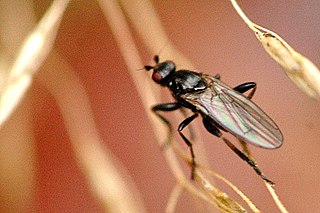
Sphaeroceridae are a family of true flies in the order Diptera, often called small dung flies, lesser dung flies or lesser corpse flies due to their saprophagous habits. They belong to the typical fly suborder Brachycera as can be seen by their short antennae, and more precisely they are members of the section Schizophora. There are over 1,300 species and about 125 genera accepted as valid today, but new taxa are still being described.
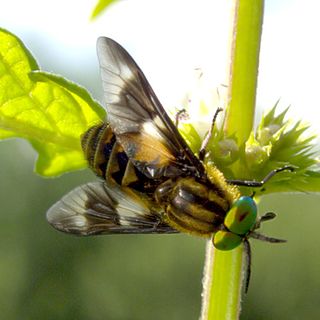
Superfamily Tabanoidea are insects in the order Diptera.
Lamprochromus is a genus of flies in the family Dolichopodidae. It is generally placed in the subfamily Sympycninae, though a molecular phylogenetic analysis of the family Dolichopodidae by Germann et al. (2011) suggested that the genus should be placed in the subfamily Rhaphiinae.

Blera is primarily a North American genus, though there are 3 species from Europe. The genus is characterized by the following characters:

Herina frondescentiae is a species of picture-winged fly in the genus Herina of the family Ulidiidae It is wetland species of about 3–4 millimetres (0.12–0.16 in) in length. found in Sweden, Finland, Denmark, Latvia, the United Kingdom, Ireland, France, Netherlands, Germany, Spain, Andorra, Italy, Hungary, Romania, Albania, Ukraine, Croatia, Estonia, Poland, Lithuania, the Czech Republic, Slovakia, and Switzerland.
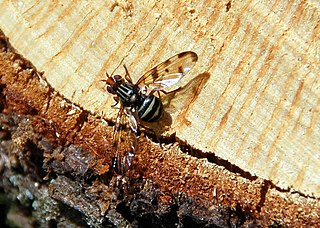
Otitinae is the name of a subfamily of flies in the family Ulidiidae. It was formerly the Otitidae. Like the Ulidiinae, most species are herbivorous or saprophagous. Most species share with the Tephritidae an unusual elongated projection of the anal cell in the wing, but can be differentiated by the smoothly curving subcostal vein. Most are dull gray to shiny brown or black flies with vein R1 setulose or, in a few cases, bare.

Callopistromyia is a genus of picture-winged flies in the family Ulidiidae.

Macquartia tenebricosa is a European species of fly in the family Tachinidae.

Eutreta is a genus of the family Tephritidae, better known as fruit flies.
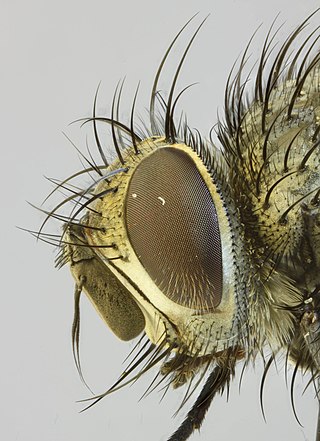
Phryxe nemea is a species of fly in the family Tachinidae.

Paykullia maculata is a species of fly in the subfamily Rhinophorinae first described by Carl Fredrik Fallén in 1815.
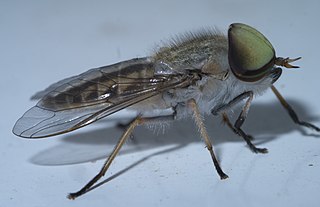
Tabaninae is a subfamily in the family Tabanidae commonly known as horse flies. There are more than 3000 described species in Tabaninae.

Diachlorini is a tribe of horse flies in the family Tabanidae.

Callopistromyia strigula is a species of picture-winged fly in the family Ulidiidae.
Total of 245 species either found or highly expected to be found in New York.
Tapeigaster annulipes is a species of fly in the family Heleomyzidae. It is endemic to Australia, occurring in New South Wales, Queensland, South Australia, Tasmania, and Victoria. It is common and widely distributed within this range and can be found in forested and urban areas alike.
















